Table of Contents
Listen to the podcast instead ?

Introduction
Who might turn away from the sweet, creamy treat that is ice cream? Whether it’s a sweltering summer afternoon or a cozy winter night, ice cream makes our taste sensations happy. For many, though, the guilt of eating regular ice cream loaded with sugar and bad fats often exceeds the pleasure. Now, enter the realm of healthy ice cream, a growing niche offering all the decadence without the unwelcome calorie count.
As a certified nutritionist with over a decade of experience in creating wholesome desserts, I’ve seen firsthand the transformative impact of healthier alternatives. From knowing what makes it healthy, investigating several varieties, and offering homemade recipes to highlighting the best brands in the United States, this thorough guide explores all you need to know about healthy ice cream. Let’s start this mouthwatering trip towards guilt-free enjoyment!
Understanding Healthy Ice Cream
What Defines Healthy Ice Cream?
Healthy ice cream isn’t just about reducing calories; it’s about enhancing nutritional value without compromising on taste.
Ingredients
Healthy ice creams typically use natural sweeteners like stevia, monk fruit, or honey instead of refined sugars. Usually, its low-fat basis is Greek yogurt or replacement milk, including almond, coconut, or oat milk. These ingredients not only cut calories but also add nutrients of worth.
Nutritional Profile
A hallmark of healthy ice cream is its lower calorie count, reduced sugar, and often higher protein or fiber content. For example, a standard serving can have around 200–300 calories, far less than conventional ice cream, and little added sugar.
Dietary Considerations
Healthy ice cream caters to a variety of dietary needs. Whether you’re vegan, following a keto diet, or need a gluten-free option, there’s likely a healthy ice cream variant tailored for you.
Benefits of Choosing Healthy Ice Cream
Health Advantages
Choosing healthy ice cream helps regulate calorie intake, so encouraging weight control. Some also include probiotics, which aid in digestion; reduced sugar content encourages improved blood sugar regulation.
Mental Well-being
Indulging in a treat without the associated guilt can boost mental well-being. Enjoying your favorite flavor mindfully enhances overall happiness and satisfaction.
Environmental Impact
Many healthful ice cream companies give sustainability a top priority and use sustainably obtained organic components, therefore improving the surroundings.
Common Myths About Healthy Ice Cream
Taste Compromise
A prevalent myth is that healthy ice cream is less tasty. On the contrary, advancements in food technology and natural flavorings have made it possible to enjoy rich, creamy textures and delightful flavors without the guilt.
Nutritional Misconceptions
There’s often confusion about sugar substitutes and fat content in healthy ice creams. Natural sweeteners used in these products are generally safer and healthier alternatives to refined sugars, and the fat content is carefully balanced to maintain creaminess without excess.
Types of Healthy Ice Cream
Low-Calorie Ice Cream
Description
Low-calorie ice creams are designed to satisfy your sweet tooth while keeping calorie intake minimal. These options use natural sweeteners and lower-fat bases to reduce overall calories without sacrificing flavor.
Popular Brands in the U.S.
- Halo Top
- Enlightened
Nutritional Comparison Table
| Brand | Calories per Serving | Sugar Content | Protein | Fat |
|---|---|---|---|---|
| Halo Top | 280 | 5g | 20g | 6g |
| Enlightened | 300 | 6g | 18g | 7g |
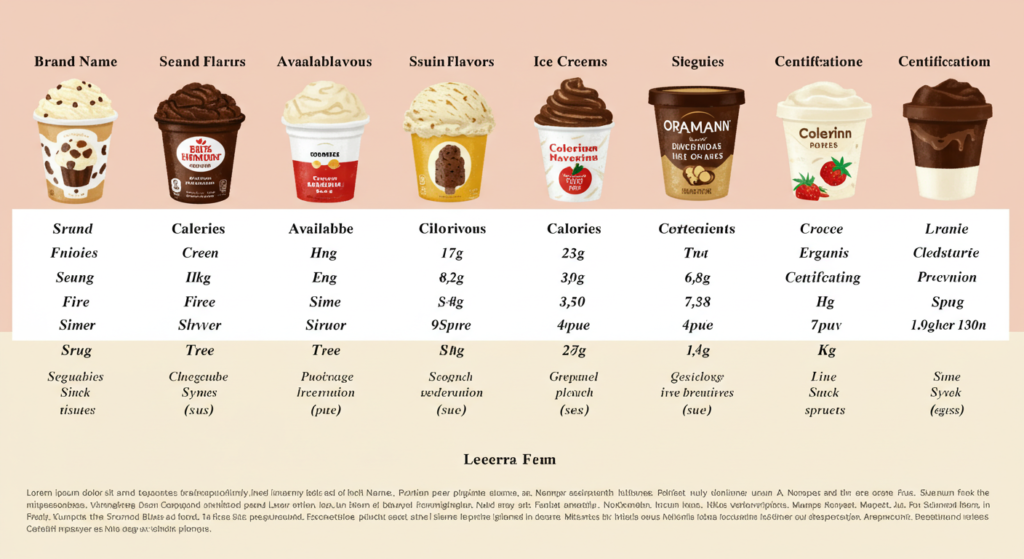
Dairy-Free Ice Cream
Base Ingredients
Dairy-free ice creams such as almond milk, coconut milk, or oat milk make a creamy texture without dairy.
Benefits
Ideal for those who are lactose-intolerant, vegan, or prefer plant-based options, dairy-free ice creams offer a flexible option that maintains both flavor and texture.
Top U.S. Brands
- Ben & Jerry’s Non-Dairy
- So Delicious
- NadaMoo!
Keto and Low-Carb Ice Cream
Carbohydrate Management
Perfect for those following a keto or low-carb lifestyle, these ice creams focus on minimizing carbohydrates to keep you in ketosis.
Key Ingredients
Commonly used ingredients include erythritol, stevia, and heavy cream to provide sweetness and creaminess without the carbs.
Recommended Brands
- Rebel Creamery
- Keto Pint
Protein-Enriched Ice Cream
Muscle Building
Designed for those who enjoy exercise and those trying to boost their protein consumption, protein-enriched ice creams are a delicious approach to helping muscles develop and heal.
Common Additives
Ingredients like whey protein and plant-based proteins are added to boost the protein content.
Popular Options
Brands such as Protein-rich store brands and specialized options cater to this market.
Natural and Organic Ice Cream
Organic Certification
Certified organic ice creams use ingredients that are grown without synthetic pesticides and free of GMOs, providing a purer and more natural product.
Natural Sweeteners
Natural sweeteners like honey, agave, and maple syrup are often preferred over artificial ones.
Leading Brands
- Organic Valley
- Talenti’s Organic Line
How to Make Healthy Ice Cream at Home
Essential Ingredients for Homemade Healthy Ice Cream
Creating your own healthy ice cream allows complete control over ingredients and flavors.
Base Ingredients
- Milk Alternatives: Almond milk, coconut milk, or oat milk.
- Greek Yogurt: Adds creaminess and protein.
- Avocados: For a rich, creamy texture without dairy.
Natural Sweeteners
- Stevia
- Monk Fruit
- Dates
Flavor Enhancers
- Vanilla Extract
- Cocoa Powder
- Fresh Fruits
Step-by-Step Recipes
Recipe 1: Vegan Banana Ice Cream
Ingredients
- 4 ripe bananas, sliced and frozen
- 1 cup coconut milk
- 2 tablespoons maple syrup
- 1 teaspoon vanilla extract
Instructions
- Process the frozen bananas in a blender or food processor until creamy
- Stir in coconut milk, a drizzle of maple syrup, and a splash of vanilla extract.
- Blend until creamy and well combined.
- Transfer to a container and freeze for at least 2 hours before serving.
Nutritional Information Table
| Nutrient | Amount per Serving |
|---|---|
| Calories | 150 |
| Sugar | 12g |
| Protein | 2g |
| Fat | 7g |
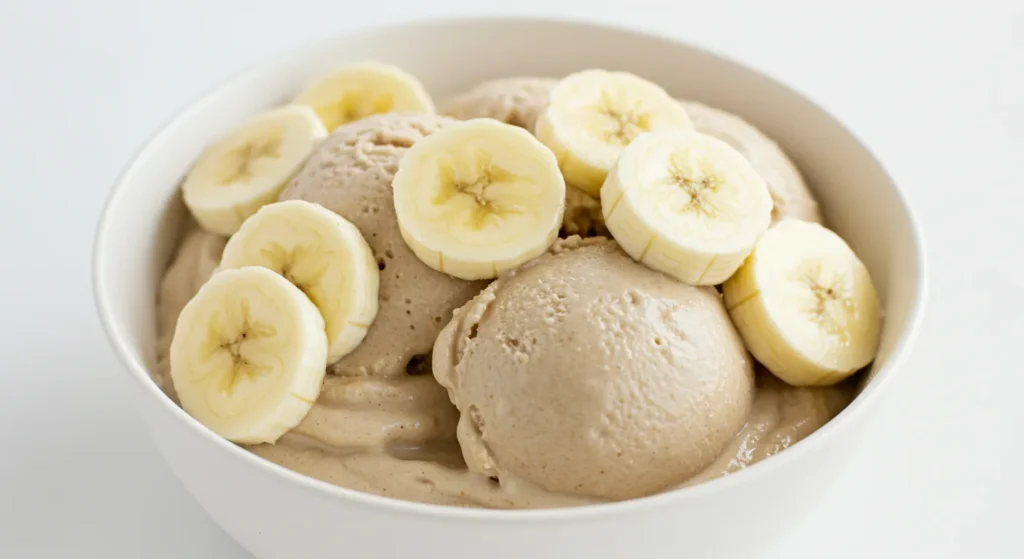
Recipe 2: Low-Sugar Chocolate Protein Ice Cream
Ingredients
- 2 cups Greek yogurt
- 1/2 cup unsweetened cocoa powder
- 3 tablespoons stevia
- 1 scoop of chocolate protein powder
- 1 teaspoon vanilla extract
Instructions
- stevia, and chocolate protein powder. Mix Greek yogurt and cocoa powder in a bowl.
- Mix until smooth and well blended.
- Stir in vanilla extract.
- Use the directions. Load the ingredients into your ice cream maker and let it churn.
- Freeze until firm before serving.
Nutritional Information Table
| Nutrient | Amount per Serving |
|---|---|
| Calories | 200 |
| Sugar | 5g |
| Protein | 25g |
| Fat | 5g |

Recipe 3: Keto Coconut Ice Cream
Ingredients
- 2 cups full-fat coconut milk
- 1/4 cup erythritol
- 1/2 teaspoon xanthan gum
- 1 teaspoon vanilla extract
Instructions
- Heat the coconut milk and erythritol in a saucepan till heated.
- Take it off the heat and blend the vanilla essence with xanthan gum.
- Let the mixture cool to room temperature, then refrigerate for 2 hours.
- Pour into an ice cream machine and swirl till creamy.
- Freeze for an additional hour before serving.
Nutritional Information Table
| Nutrient | Amount per Serving |
|---|---|
| Calories | 180 |
| Sugar | 2g |
| Protein | 3g |
| Fat | 16g |
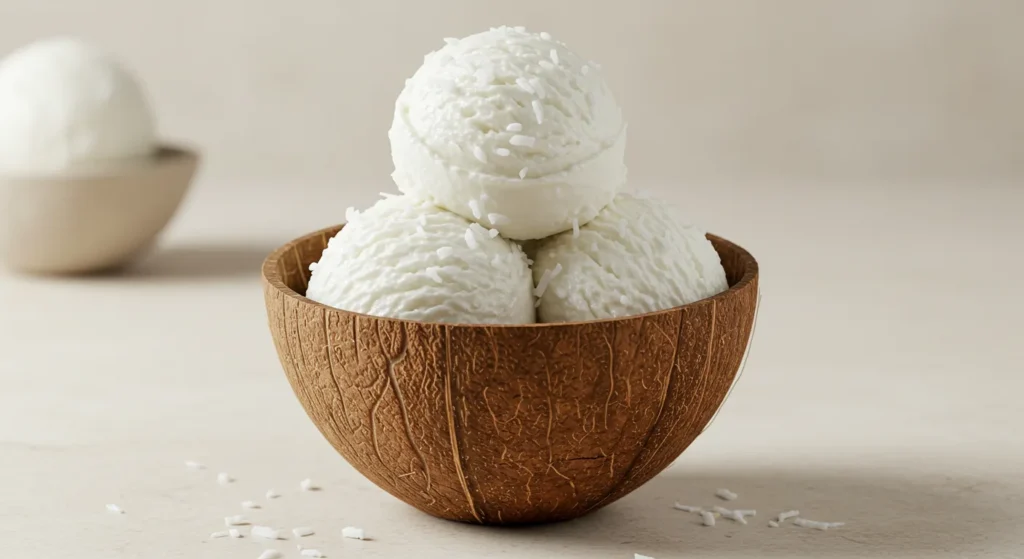
Tips for Perfect Homemade Ice Cream
Texture Tips
Getting the right texture calls for careful freezing and churning. For a smooth consistency, use an ice cream maker and make sure components are well-blended.
Flavor Balancing
Balance sweetness and flavor by adjusting natural sweeteners and enhancing with extracts or spices. Taste the mixture before freezing to ensure optimal flavor.
Storage Advice
Keeping homemade ice cream in sealed containers will help to prevent ice crystals. For best results, freeze for at least 4 hours before serving.
Comparing Store-Bought vs. Homemade Healthy Ice Cream
Nutritional Comparison
Store-Bought Advantages
- Convenience: Ready to eat without any preparation.
- Variety: A wide range of flavors and types are available.
Homemade Advantages
- Control Over Ingredients: Customize based on dietary needs and preferences.
- Customization: Tailor flavors and add-ins to personal taste.
Comparison Table
| Aspect | Store-Bought | Homemade |
|---|---|---|
| Calorie Control | Limited options | Fully customizable |
| Ingredient Quality | Varies by brand | High-quality, chosen by you |
| Cost | Can be expensive | Generally cheaper per batch |
| Convenience | Ready to eat | Requires preparation |
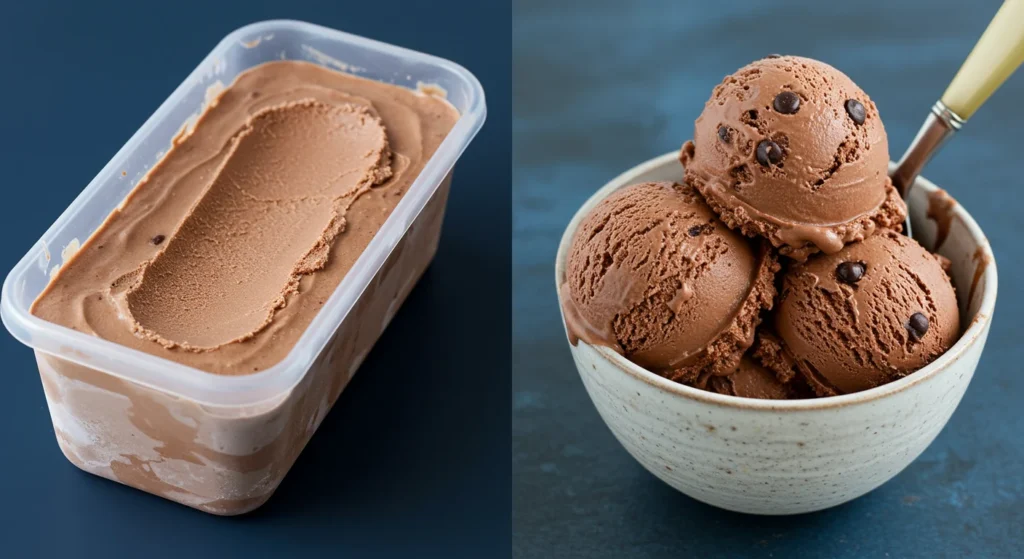
Cost Analysis
Price Per Serving
Store-bought healthy ice creams can range from $4 to $8 per pint, depending on the brand and specialty features. Homemade ice cream typically costs around $2 to $4 per batch, making it a more economical choice in the long run.
Value for Money
Although store-bought choices are more convenient, handmade ice cream is more reasonably priced by permitting bulk preparation and lower per-serving costs. Furthermore, the option to personalize ingredients is valuable.
Taste and Texture
Flavor Profiles
While homemade ice cream offers total control over taste strength and ingredient combinations, store-bought brands can play with unusual flavors and textures.
Consistency
Commercial ice creams are churned with industrial equipment, resulting in consistently smooth textures. Homemade versions can vary based on the method used, but with practice, you can achieve comparable results.
Top Healthy Ice Cream Brands in the U.S.
Halo Top
Overview
Beginning in 2012, Halo Top transformed the ice cream market with its low-calorie, high-protein products. Health-conscious consumers love the brand since its concept is to offer excellent ice cream free of guilt.
Popular Flavors
- Vanilla Bean
- Chocolate
- Peanut Butter Cup
Nutritional Highlights
Halo Top ice creams often include 280 calories per pint and only 5 grams of sugar and 20 grams of protein for people striving for a balanced dessert.
Overview
Enlightened is dedicated to making decadent and healthful ice creams. Their goods appeal to a wide spectrum of dietary requirements by concentrating on low sugar and high fiber counts.
Popular Flavors
- Sea Salt Caramel
- Mint Chip
Nutritional Highlights
Enlightened provides a good pleasure without adding too many calories to your daily intake—about 300 calories and 6 grams of sugar per pint.
So Delicious
Overview
A leader in dairy-free ice creams, So Delicious offers a wide array of plant-based options. Their commitment to quality and taste has made them a staple in many households.
Popular Flavors
- Coconut Milk Chocolate
- Almond Milk Vanilla
Nutritional Highlights
Therefore, delicious ice creams fit many dietary restrictions since they are plant-based, allergen-friendly, and usually low in sugar content per serving.
Rebel Creamery
Overview
Specializing in keto-friendly options, Rebel Creamery caters to those following low-carb and ketogenic diets. Their ice creams are crafted to maintain ketosis while providing rich, creamy flavors.
Popular Flavors
- Chocolate Peanut Butter
- Vanilla Bean
Nutritional Highlights
Rebel Creamery ice creams are low in carbs and high in healthy fats, with flavors containing around 150 calories per serving and minimal sugar content.
Other Notable Brands
Talenti’s Organic Line
Talenti is a premium organic range with responsibly obtained, premium ingredients. Flavors like Chocolate and Sea Salt Caramel are made to be both flavor and nutritional value delivery tools.
Protein-Rich Brands
For those focused on fitness, brands like Protein-rich offer ice creams with added whey or plant-based proteins, ensuring each serving supports muscle growth and recovery.
Nutritional Breakdown of Healthy Ice Cream
Calories and Macronutrients
Caloric Content
Healthy ice creams typically range from 150 to 300 calories per serving, significantly lower than traditional ice creams, which can exceed 500 calories per serving.
Macronutrient Distribution
- Protein: Ranges from 2g to 25g per serving, depending on the brand and type.
- Fats: Varies from 3g to 16g, sourced from healthy fats like those in coconut milk or avocados.
- Carbohydrates: Generally kept low, especially in keto and low-carb varieties, with around 2g to 12g per serving.
Sugar Content and Alternatives
Natural vs. Artificial Sweeteners
Healthy ice creams utilize natural sweeteners such as stevia, erythritol, and monk fruit; generally regarded as safer substitutes for artificial sweeteners, they have little effect on blood sugar levels.
Common Sugar Alternatives
- Stevia: A plant-based sweetener that provides sweetness without calories.
- Erythritol: A sugar alcohol that offers bulk and sweetness with fewer calories.
- Monk Fruit: a naturally occurring sweetener heavy in antioxidants from monk fruit. high in antioxidants.
Vitamins and Minerals
Essential Nutrients
Healthy ice creams often contain calcium, vitamin D, and potassium, essential for bone health and muscle function.
Added Supplements
Some brands fortify their ice creams with probiotics for gut health, fiber for digestive benefits, and additional protein to support muscle growth.
Dietary Labels and Certifications
Understanding Labels
Labels like organic, non-GMO, and gluten-free provide buyers confidence about the quality and safety of the goods.
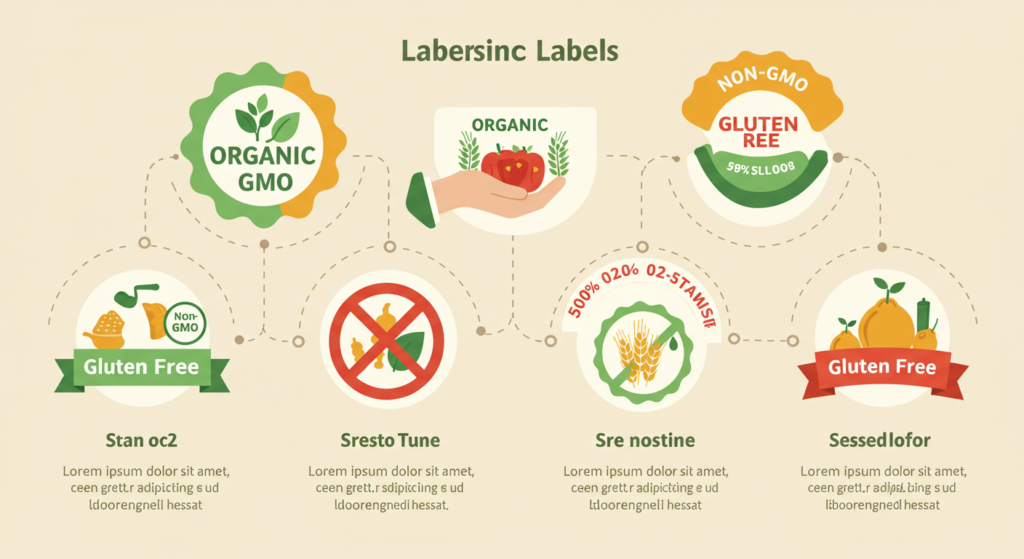
Certification Importance
Certifications ensure that the good meets particular standards, thereby enhancing customer confidence and quality control.
Health Considerations and Potential Downsides
Allergens and Sensitivities
Common Allergens
While many healthy ice creams are free of common allergies, it’s important to look for substances like dairy, almonds, and soy, which can cause allergic reactions.
Alternative Options
Many companies provide free-from-ice creams so that those with certain allergies or sensitivities may enjoy their delicacies without risk.
Sugar Substitutes and Health
Pros and Cons
While natural sweeteners are healthier alternatives to refined sugars, they can still have potential side effects. For example, excessive consumption of sugar alcohols like erythritol can lead to digestive issues.
Consumer Preferences
One has to juggle flavor with health. Natural sweeteners appeal to some consumers more than synthetic ones, which would change their overall degree of enjoyment with the product.
Portion Control and Consumption Tips
Serving Sizes
Adhering to recommended portion sizes, typically half a cup to one cup, can help in enjoying the treat without overindulging.
Mindful Eating
Practicing mindful eating—paying attention to the flavors and textures—can enhance satisfaction and prevent overeating.
Trends and Innovations in Healthy Ice Cream
Plant-Based and Alternative Proteins
Emerging Ingredients
Innovations include the use of pea protein, hemp protein, and other plant-based proteins to boost the nutritional profile without compromising taste.
Market Growth
The demand for plant-based options continues to surge, Motivated by growing knowledge of human health and environmental sustainability.
Functional Ice Creams
Added Benefits
Functional ice creams incorporate ingredients like probiotics, adaptogens, and superfoods to offer additional health benefits beyond essential nutrition.
Popular Functional Ingredients
- Turmeric: Known for its anti-inflammatory properties.
- Matcha: Rich in antioxidants.
- Chia Seeds: High in fiber and omega-3 fatty acids.
Sustainable and Ethical Practices
Eco-Friendly Packaging
To lower environmental effects, companies are using biodegradable materials and recyclable containers, among other sustainable packaging alternatives.
Ethical Sourcing
Commitment to fair trade and sustainable ingredients ensures that products are ethically produced, supporting both consumers and the planet.
Customization and Personalized Nutrition
Personalized Flavors
Customizable flavors allow companies to help customers fit their ice cream to particular dietary requirements and taste preferences.
Technology Integration
Innovative apps and tools enable users to create personalized recipes, enhancing the overall ice cream experience.
Where to Buy Healthy Ice Cream in the U.S.
Supermarkets and Grocery Stores
Major Retailers
Major stores, including Walmart, Whole Foods, and Trader Joe’s, provide healthy ice creams readily accessible to most people.
Product Availability
Look for healthy ice creams in the freezer aisle, often alongside traditional options, with dedicated sections for low-calorie, dairy-free, and protein-enriched varieties.
Specialty Health Stores
Health-Focused Retailers
Stores like Sprouts Farmers Market and Natural Grocers specialize in health-conscious products, offering a curated selection of healthy ice creams.
Exclusive Brands
These stores provide a greater range for customers by typically carrying exceptional brands and flavors not seen in major supermarkets.
Online Shopping and Delivery
E-commerce Platforms
Websites like Amazon and brand-specific online stores offer convenient shopping options, with delivery straight to your doorstep.
Subscription Services
Services like Monthly ice cream delivery boxes provide a rotating selection of healthy ice creams, allowing you to try new flavors regularly.
Local Ice Cream Parlors and Artisanal Shops
Supporting Local Businesses
Buying from local producers not only supports small businesses but also ensures fresher, high-quality products.
Unique Flavors and Ingredients
Offering a gourmet ice cream experience, artisan businesses sometimes dabble with unusual tastes and quality ingredients.
Conclusion
Recap of Key Points
Selecting good ice cream choices is a great way to enjoy your favorite treat without compromising your health. From low-calorie, dairy-free choices to protein-enriched, organic variants, there is a healthy ice cream to fit every palate and dietary requirement. Beyond personal health, the advantages help to improve mental well-being and environmental sustainability.
Encouragement to Explore and Experiment
Try fresh tastes and play about with handmade dishes without delay. There’s always something interesting to find whether your taste in ice cream is fresh to the scene or seasoned. Share your favorite healthy ice cream recipes and selections with friends and relatives so they may have guilt-free delight.
Call to Action
All set to start your trip via healthy ice cream? Subscribe to our blog for other great recipes, brand reviews, and health advice. Follow us on social media to keep informed about the most recent developments in healthful treats. Please share your stories and become part of our community of health-conscious ice cream aficionados! Additional Resources
References and Studies
- Harvard School of Public Health: Benefits of low-sugar diets.
- Journal of Nutrition: Impact of probiotics in dairy products.
- Environmental Research Letters: Sustainable practices in food production.
Additional Resources
To further enhance your journey into the world of healthy ice cream, we’ve curated a list of authoritative resources, comprehensive studies, delicious recipes, and helpful tools. These resources will provide you with deeper insights, practical tips, and additional information to make informed and enjoyable choices.
References and Studies
- Harvard T.H. Chan School of Public Health: The Nutrition Source
- Explore extensive information on nutrition, including the benefits of various ingredients used in healthy ice creams.
- USDA FoodData Central
- Access detailed nutritional data for a wide range of foods, helping you understand the nutritional profiles of different ice cream ingredients.
- Journal of Nutrition: Research on Dairy Alternatives
- Read peer-reviewed studies focusing on the health impacts and benefits of dairy-free ice cream alternatives.
Further Reading
- Healthline: The Best Low-Calorie Ice Creams
- Discover top low-calorie ice cream brands and why they stand out in the market.
- Eat This, Not That!: Healthy Ice Cream Alternatives
- Learn about various healthy ice cream options and how they compare to traditional ice creams.
- Mindbodygreen: Homemade Healthy Ice Cream Recipes
- Get inspired with a collection of easy and nutritious homemade ice cream recipes.
Helpful Tools and Websites
- MyFitnessPal: Track Your Ice Cream Intake
- Use this tool to monitor your calorie and nutrient intake, ensuring your ice cream indulgences fit within your dietary goals.
- Yummly: Customizable Healthy Ice Cream Recipes
- Access a vast library of customizable recipes to create your perfect healthy ice cream at home.
- Sprinkles Ice Cream Maker: DIY Tools
- Explore tools and equipment that make homemade ice cream preparation easy and enjoyable.
Recipes and DIY Guides
- Minimalist Baker: Vegan Banana Ice Cream
- A simple, delicious recipe for creamy vegan banana ice cream using just a few natural ingredients.
- Allrecipes: Low-Sugar Chocolate Protein Ice Cream
- Follow this step-by-step guide to make a rich, low-sugar chocolate protein ice cream perfect for fitness enthusiasts.
- KetoConnect: Keto Coconut Ice Cream
- Learn how to create a decadent keto-friendly coconut ice cream that aligns with your low-carb lifestyle.
Top Healthy Ice Cream Brands
- Halo Top Official Website
- Explore Halo Top’s range of low-calorie, high-protein ice creams and discover new flavors.
- Enlightened Official Website
- Learn about Enlightened’s mission to provide delicious, healthier ice cream options with reduced sugar and increased fiber.
- So Delicious Official Website
- Discover a variety of dairy-free ice creams made from almond, coconut, and oat milks.
Government and Health Organizations
- Centers for Disease Control and Prevention (CDC): Sugar and Nutrition
- Understand the impact of sugar on health and how to make healthier dietary choices.
- Food and Drug Administration (FDA): Nutrition Labels
- Learn how to read and understand nutrition labels to make informed decisions about your ice cream purchases.
Community and Support
- Reddit: r/HealthyIceCream
- Join a community of ice cream enthusiasts sharing recipes, tips, and reviews of healthy ice cream options.
- Facebook Groups: Healthy Dessert Lovers
- Connect with others who enjoy healthy desserts and exchange ideas for guilt-free indulgences.
Educational Videos
- YouTube: How to Make Healthy Ice Cream at Home
- Watch instructional videos on making various types of healthy ice cream, from vegan to low-carb options.
- TED Talks: The Science of Healthy Eating
- Gain insights from experts on the importance of healthy eating and how it relates to enjoying treats like ice cream responsibly.
By leveraging these resources, you’ll be well-equipped to navigate the healthy ice cream landscape, make informed choices, and enjoy delicious, nutritious frozen treats. Whether you’re looking to explore new brands, create your own recipes, or understand the nutritional science behind your favorite flavors, these links offer valuable guidance and support.
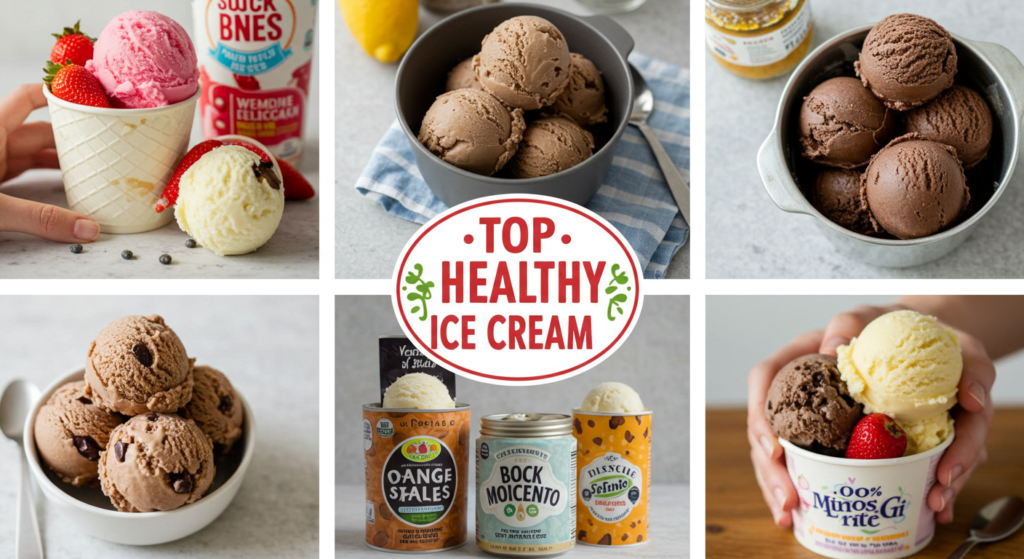
Frequently Asked Questions (FAQ)
Q1: Are healthy ice creams suitable for weight loss? A1: Yes, many healthy ice creams are designed to be low in calories and sugar, making them ideal for weight management when consumed in moderation.
Q2: Can I make healthy ice cream without an ice cream maker? A2: Absolutely! There are several no-churn recipes available that use ingredients like Greek yogurt or bananas to achieve a creamy texture.
Q3: Are sugar substitutes in healthy ice creams safe? A3: Natural sweeteners, including monk fruit and stevia, are usually regarded as safe. Still, one should eat them in moderation and be conscious of any personal sensitivity.
Glossary of Terms
- Probiotics: Live, helpful bacteria for digestive health.
- Erythritol: A sugar alcohol used as a low-calorie sweetener.
- Adaptogens: Natural compounds supporting bodily adaptation to stress.
- Xanthan Gum: A thickening ingredient meant to enhance the texture of ice cream.
Including the newest trends, thorough nutritional information, and helpful advice guarantees that you are ready to make wise selections on savoring nutritious ice cream. Whether you’re making your own at home or shopping from a store, the opportunities for mouthwatering, guilt-free treats abound.
Ready to transform your dessert experience? Dive into the world of healthy ice cream today and savor every guilt-free bite!

